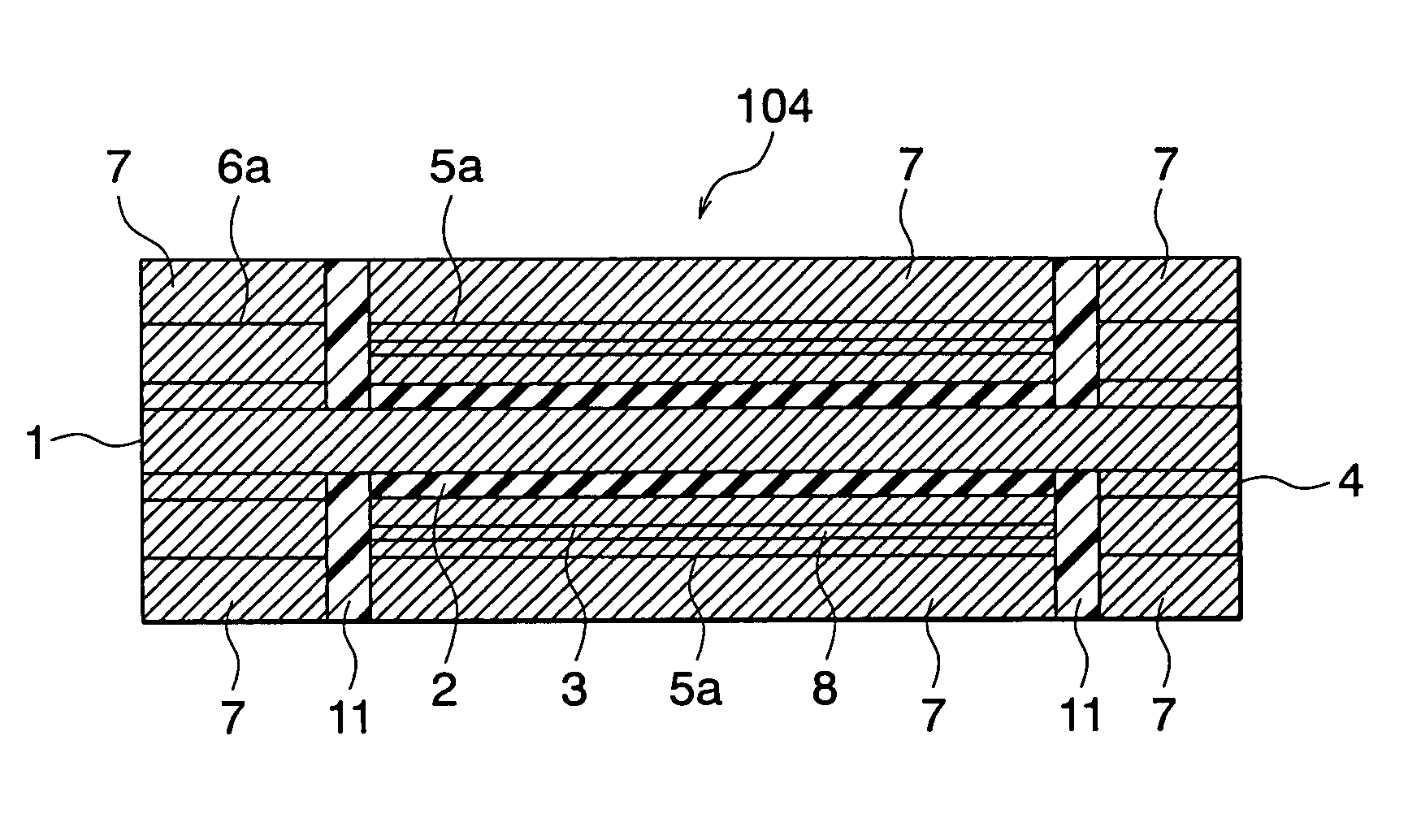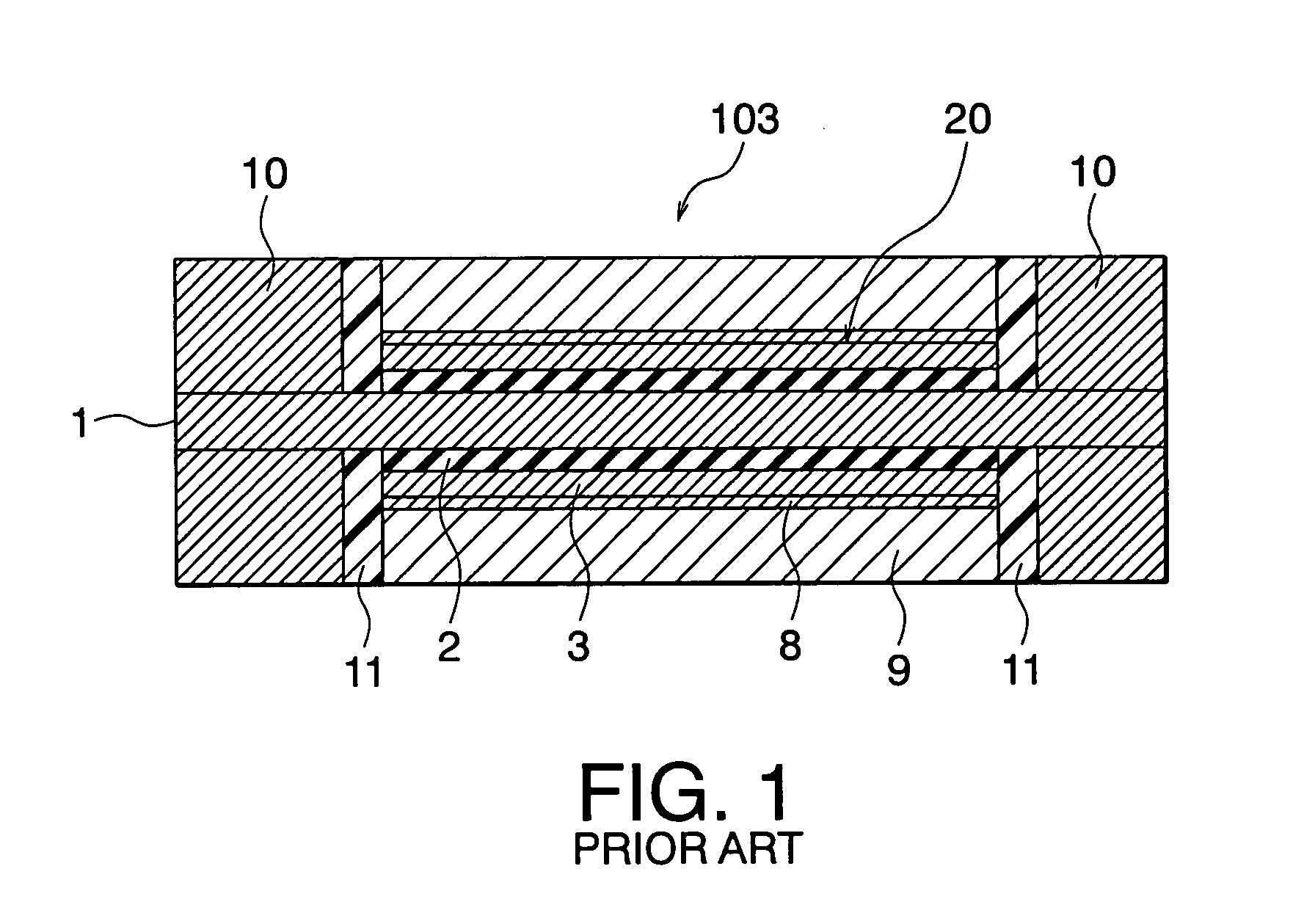Solid electrolytic capacitor, stacked capacitor using the same, and fabrication method thereof
- Summary
- Abstract
- Description
- Claims
- Application Information
AI Technical Summary
Benefits of technology
Problems solved by technology
Method used
Image
Examples
example 1
[0049] In a basic element 20 shown in FIG. 5, a conductive polymer layer 3 in the form of a conductive polymer film is formed on a dielectric oxide film 2 of an aluminum foil 1 formed with the dielectric oxide film 2 by surface roughening. Symbol 11 denotes a resist for dividing into an anode portion and a cathode portion. In the basic element 20 after the formation of the conductive polymer film, a copper plating layer was directly formed as a first metal plating layer (I) 5a on the cathode portion conductive polymer layer 3 as shown in FIG. 3. Alternatively, after forming a graphite layer 5b on the cathode portion conductive polymer layer 3, a copper plating layer was formed as a first metal plating layer (I) 5a. Then, the respective samples were each applied, as a pretreatment for anode portion copper plating, with a zincate treatment, with gold deposition, platinum deposition, or carbon deposition to form an anode deposition film 4, with masking so as not to form the oxide film ...
example 2
[0051] As shown in FIG. 3, a first metal plating layer (I) 5a on polypyrrole and a second metal plating layer (II) 6a on a metal deposition layer 4 were formed by copper plating, respectively, according to the foregoing copper plating method and third metal plating layers (III) 7 were each formed by a copper-tin alloy plating layer, thereby preparing a solid electrolytic 101.
[0052] As shown in FIG. 4, a nickel plating layer was formed as a first layer 5a of a first metal plating layer (I) on a basic element 20 and a copper plating layer was formed as a second layer 5b on the first layer 5a, while, likewise, a nickel plating layer was formed as a first layer 6a of a second metal plating layer (II) and a copper plating layer was formed as a second layer6b on the first layer 6a, and third metal plating layers (III) 7 were each formed by a copper-tin alloy plating layer, thereby preparing a solid electrolytic capacitor 102.
[0053] As shown in FIG. 6, a graphite layer 8 was formed on a ...
example 3
[0056] After forming a plurality of solid electrolytic capacitors 101 on the frames shown in FIG. 8, the frames were stacked together and then copper-tin alloy plating layers 7 as third metal plating layers (III) 7 were heated and melted at 230° C. to 350° C. so as to be bonded together, thereby producing five-layer stacked capacitors 105 of this invention.
[0057] Further, the frames shown in FIG. 9 were stacked together at predetermined positions, then solid electrolytic capacitors 107 were joined together by the use of conductive paste and then cut at predetermined portions, thereby producing five-layer stacked capacitors 106.
[0058] For comparison, there was produced a conventional five-layer stacked capacitor 108 using graphite, silver paste, and terminal plates as shown in FIG. 2.
[0059]FIG. 10 shows frequency-impedance characteristics of the stacked capacitors 105, 106, and 108, respectively.
[0060] As shown in FIG. 10, it is understood that the impedance of the stacked capaci...
PUM
| Property | Measurement | Unit |
|---|---|---|
| Melting point | aaaaa | aaaaa |
| Melting point | aaaaa | aaaaa |
| Frequency | aaaaa | aaaaa |
Abstract
Description
Claims
Application Information
 Login to View More
Login to View More - R&D
- Intellectual Property
- Life Sciences
- Materials
- Tech Scout
- Unparalleled Data Quality
- Higher Quality Content
- 60% Fewer Hallucinations
Browse by: Latest US Patents, China's latest patents, Technical Efficacy Thesaurus, Application Domain, Technology Topic, Popular Technical Reports.
© 2025 PatSnap. All rights reserved.Legal|Privacy policy|Modern Slavery Act Transparency Statement|Sitemap|About US| Contact US: help@patsnap.com



